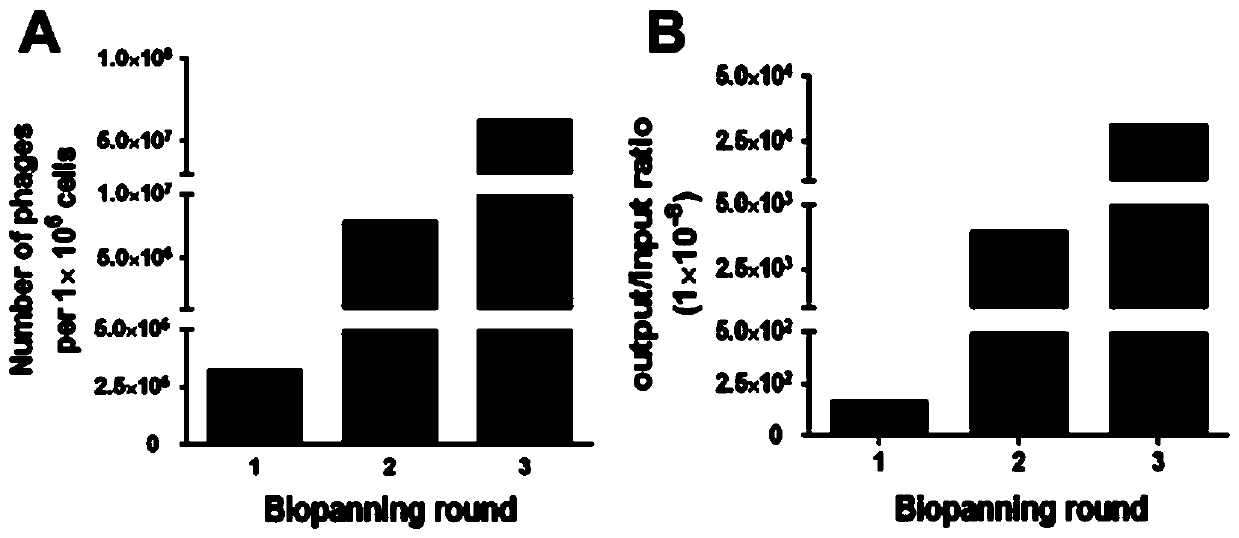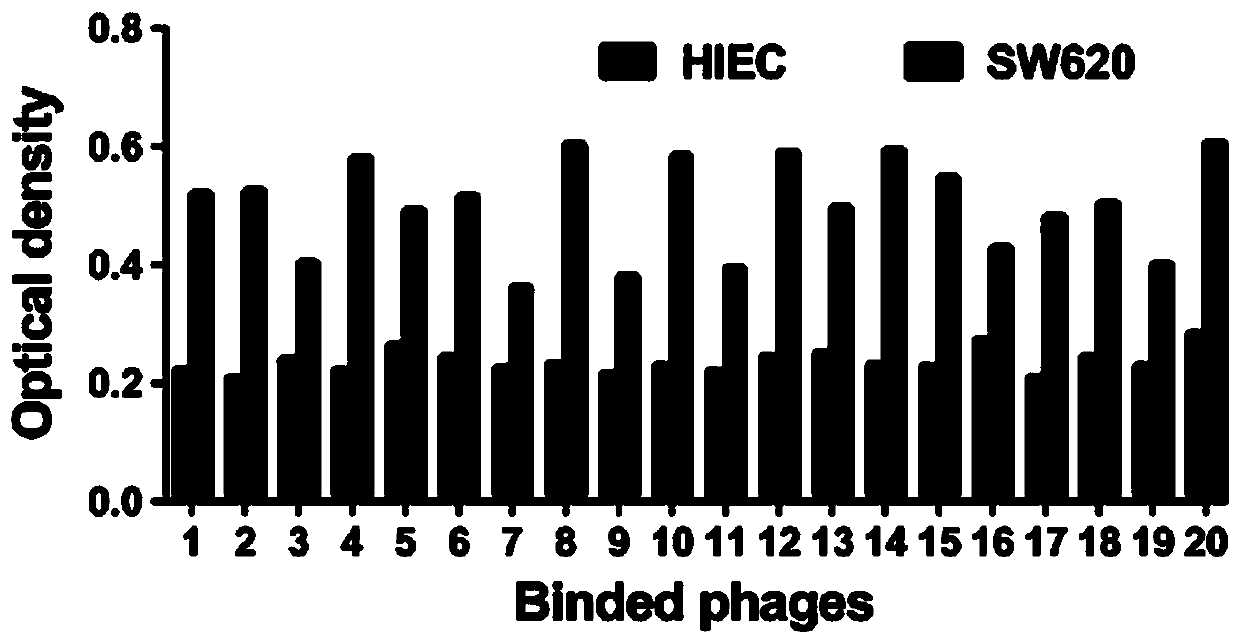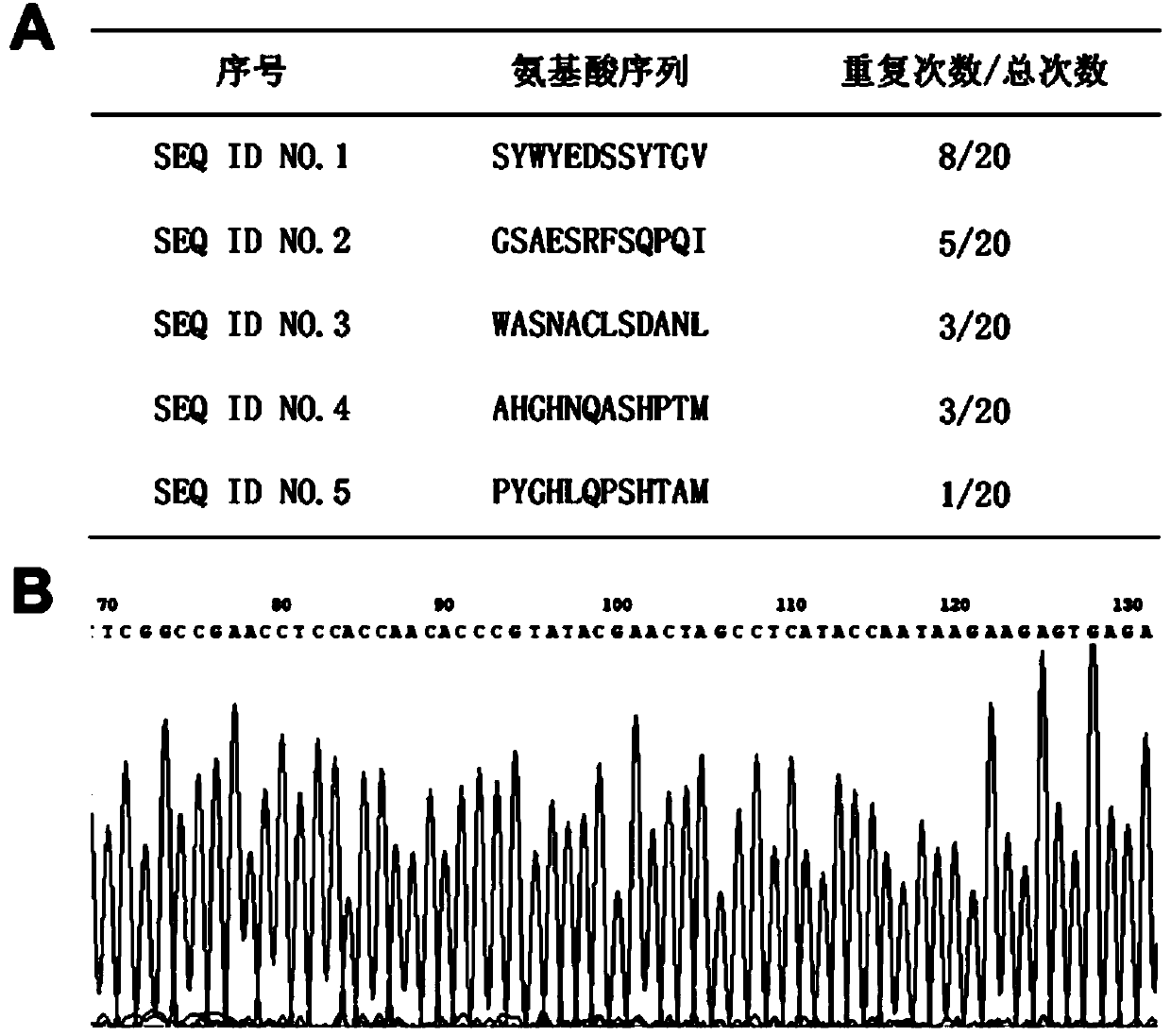Novel polypeptide specifically bound with multiple tumor cells and application thereof
A tumor cell-specific technology, applied in the field of biomedicine, can solve the problems of easy uptake by the phagocytic system, poor cell membrane penetration, and application limitations, and achieve small relative molecular weight, simple synthesis and purification steps, and immunogenicity weak effect
- Summary
- Abstract
- Description
- Claims
- Application Information
AI Technical Summary
Problems solved by technology
Method used
Image
Examples
Embodiment 1
[0037] Example 1 Three rounds of subtractive screening of intestinal cancer cell-specific binding-positive polypeptides using phage display technology.
[0038] 1.1 Recovery and cultivation of host bacteria E.coli ER2738.
[0039] To prepare an E. coli plate, take the LB-TET culture plate and preheat it in a 37-degree incubator for 1 hour. After the E.coli ER2738 bacterial liquid melts, use an inoculation loop to dip a small amount of bacterial liquid evenly on the culture plate, and then place it upside down at 37°C overnight in a constant temperature incubator. Prepare the host bacterial liquid, put a single colony picked from a well-grown culture plate into the LB bacterial culture medium containing tetracycline, and cultivate overnight at 37°C and 180rpm shaking, and stop the shaking when the bacteria are in the logarithmic growth phase. The LB-Tet plate containing E. coli was prepared and stored in a 4°C refrigerator for later use, and the host bacterial solution was sto...
Embodiment 2
[0061] Example 2 Enzyme-linked immunosorbent assay was used to detect the affinity of positive phage clones to intestinal cancer cells.
[0062] 2.1 Purification of positive phage clones.
[0063] 2.1.1 Amplification of positive phages: Add 20ml LB / Tet liquid medium to the Erlenmeyer flask, then add Escherichia coli liquid and phage to be amplified at a ratio of 1:100, place at 37ºC, shake vigorously in a constant temperature shaker for 4.5 h, the amplification solution of phage was obtained.
[0064] 2.1.2 Purification of positive phage: centrifuge the phage amplification solution obtained through the above steps at 4ºC and 12000r / min for 10min, take the supernatant, add 1 / 6 volume of PEG-NaCl to precipitate overnight, centrifuge at 12000r / min for 15min, discard Remove the supernatant, dissolve the precipitate with TBS buffer, give 1 / 6 volume PEG-NaCl again, and incubate on ice for 1 h. 4ºC, 14000r / min, centrifuge for 15min, discard the supernatant, dissolve the obtained pr...
Embodiment 3
[0077] Example 3 Determination and analysis of DNA sequences of positive phage clones.
[0078] 3.1. Selection of positive monoclonal phages.
[0079] The phage liquid obtained after the third round of screening was titered and spread on LB plates. On the plate with less than 50 plaques, 20 blue spots with good growth at intervals of 5 mm were randomly selected. Add 20 randomly picked blue spots to 1ml pre-logarithmic host bacterial solution (same as phage amplification), and amplify at 37°C and 200rpm with rapid shaking for 4.5 hours.
[0080] 3.2 Positive monoclonal phage single-stranded DNA extraction.
[0081]Centrifuge the amplified monoclonal phage liquid at 4°C and 14,000 rpm for 30 seconds, transfer the supernatant to a new tube, centrifuge at 4°C and 1,000 rpm for 30 seconds, and transfer 80% of the supernatant to a new nuclease-free centrifuge In the tube, take 300ul of bacterial liquid and add 300ul of glycerol at a ratio of 1:1, and store it in a -20 degree refri...
PUM
 Login to View More
Login to View More Abstract
Description
Claims
Application Information
 Login to View More
Login to View More - R&D
- Intellectual Property
- Life Sciences
- Materials
- Tech Scout
- Unparalleled Data Quality
- Higher Quality Content
- 60% Fewer Hallucinations
Browse by: Latest US Patents, China's latest patents, Technical Efficacy Thesaurus, Application Domain, Technology Topic, Popular Technical Reports.
© 2025 PatSnap. All rights reserved.Legal|Privacy policy|Modern Slavery Act Transparency Statement|Sitemap|About US| Contact US: help@patsnap.com



